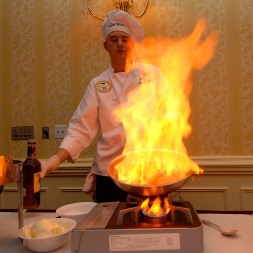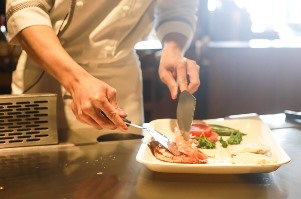Chef Schools
How to Choose the Right One Near South Valley New Mexico
 You have made a great career choice to become a cook or chef by enrolling in a culinary institute near South Valley NM. You will not only learn how to cook extraordinary dishes or prepare elegant desserts, you'll also be able to make a nice income doing it. However, exactly how do you set about picking a culinary institute now that you've decided to enroll? What criteria should you research and compare among the contending cooking schools before arriving at your ultimate selection? Bear in mind that you must choose the appropriate program and degree if you want to be successful in the restaurant and hospitality fields. There are a wide range of alternatives to select from, starting with a diploma or certificate program and advancing to earning an undergraduate as well as a graduate degree. You can attend a small baking school, an online training class, or enroll in a prestigious culinary institute that provides advanced degrees. The type of degree and school you decide on will probably be based upon the amount of money and time you can afford to commit, as well as your ultimate career objective. Once you have decided what your main area of interest and budget are, you can begin evaluating the cooking programs that meet your initial requirements. Depending upon the certification and type of culinary school you select, you could be employed as a professional chef or cook in as little as 6 months. So before we dive more into the system of selecting a school, let's talk a little bit more about the degree and culinary school choices that are available.
You have made a great career choice to become a cook or chef by enrolling in a culinary institute near South Valley NM. You will not only learn how to cook extraordinary dishes or prepare elegant desserts, you'll also be able to make a nice income doing it. However, exactly how do you set about picking a culinary institute now that you've decided to enroll? What criteria should you research and compare among the contending cooking schools before arriving at your ultimate selection? Bear in mind that you must choose the appropriate program and degree if you want to be successful in the restaurant and hospitality fields. There are a wide range of alternatives to select from, starting with a diploma or certificate program and advancing to earning an undergraduate as well as a graduate degree. You can attend a small baking school, an online training class, or enroll in a prestigious culinary institute that provides advanced degrees. The type of degree and school you decide on will probably be based upon the amount of money and time you can afford to commit, as well as your ultimate career objective. Once you have decided what your main area of interest and budget are, you can begin evaluating the cooking programs that meet your initial requirements. Depending upon the certification and type of culinary school you select, you could be employed as a professional chef or cook in as little as 6 months. So before we dive more into the system of selecting a school, let's talk a little bit more about the degree and culinary school choices that are available.
It Takes Just a Few Minutes to Start Your Culinary Arts Career Below!
Culinary Arts Institute Degree Options

As with a number of other industries or professions in South Valley NM, there are a variety of degree options that are offered in the culinary arts. At the most basic level, you can sign up for a local cooking course, which are more informal in nature and can last from just a few hours to several weeks. Often a certificate or a diploma is presented at the time of completion. They can be broad in nature, for instance instructing how to cook Italian dishes, or they can be very specific and concentrate on one dish, for instance Crepes Suzette. Naturally if you are seeking a more conventional education applicable for a career in the restaurant profession, you will probably choose to pursue a degree program. With a degree program, you will be obligated to devote significantly more time.
- Associate's Degrees can require anywhere from 6 months to 2 years to finish.
- Bachelor's Degrees generally call for as much as four years of education.
- Masters Degrees can take an added two years or more after attaining a Bachelor's.
Even more advanced training options may be available, including specialized or Doctoral programs made available by culinary arts institutes. Probably the most important point to remember when deciding on which degree to strive for is ensuring that it provides the education and degree needed to advance your ultimate career objectives.
Culinary Arts Institutes

Once you have made your choice regarding the kind of instruction and degree that you would like to pursue, you can start your search for the culinary arts school, college or institute that offers it. For example, if your goal is to train to be a chef specializing in French cuisine, then naturally you will concentrate on those colleges that furnish the proper training. Or you can select an institute based on its reputation or other criteria (we'll cover a few of those later) and then choose the most suitable degree program available that is consistent with your career objectives in South Valley NM. However you make your choice, culinary arts schools typically fall under three distinct categories:
- Cooking Schools. Some cooking schools do offer degree programs, but generally they offer diplomas or certificates. Their programs tend to be more focused in nature, and they can range anywhere from one or two months to as long as 3 or 4 years.
- Community Colleges. Local community colleges can be more economical than the majority of private schools and many have excellent programs. They almost solely offer Associate's Degrees and are founded and managed by either local or state governments.
- Culinary Schools and Institutes. The more advanced degrees and training are offered by culinary schools and institutes. Several institutes provide the most respected and highest level of training in academia. But bear in mind, since they are private schools they tend to be more expensive than their public counterparts, some a lot more.
Selecting a culinary arts school will not only be dependent on the kind of degree or program you wish to pursue, but also how much you have to spend on your education. If you decide to enroll in a public school to minimize expenses, remember that out-of-state residents usually must pay a higher tuition than in-state residents. Furthermore, a lot of community colleges and regional public schools have lower tuition charges for area residents. So don't forget to research the public options within New Mexico as well as within the South Valley NM area to discover the most affordable options.
Online Culinary Programs
 A number of prospective students may find that there are no cooking schools that are within commuting proximity of their South Valley NM home. One solution is to attend online training within the convenience of one's home. The practicality and flexibility makes it the best solution for a number of students that are still working full-time while attending school. Plus there are more schools online than ever that are accredited. Bear in mind that a considerable portion of the instruction will be furnished through an externship. Externships are programs where students work under regional chefs or other cooking practitioners to ensure that they receive hands-on training beyond the online classroom. Just make sure that the online school you decide on is accredited by a U.S. Department of Education approved agency (more on this later). So if you are dedicated enough to be able to participate in classes and study in this more independent manner, earning a culinary arts degree online might be the best option for you.
A number of prospective students may find that there are no cooking schools that are within commuting proximity of their South Valley NM home. One solution is to attend online training within the convenience of one's home. The practicality and flexibility makes it the best solution for a number of students that are still working full-time while attending school. Plus there are more schools online than ever that are accredited. Bear in mind that a considerable portion of the instruction will be furnished through an externship. Externships are programs where students work under regional chefs or other cooking practitioners to ensure that they receive hands-on training beyond the online classroom. Just make sure that the online school you decide on is accredited by a U.S. Department of Education approved agency (more on this later). So if you are dedicated enough to be able to participate in classes and study in this more independent manner, earning a culinary arts degree online might be the best option for you.
Contrasting Culinary Institutions
By now you should have made a decision regarding the type of degree that you wish to earn, and whether or not you would like to enroll in a public or private school. Since there are numerous cooking programs in the South Valley area and within the United States, you will want to develop a checklist of important qualifications so that you can begin narrowing down your options. Some obvious qualifications, such as cost and location are an excellent place to begin. But picking a school because it is the nearest or the least expensive is not the optimal way to decide on your education. There are other considerations, for example accreditation and reputation that you should review as well. So following are some critical areas that you will need to investigate for every school as you compare and contrast them and make your ultimate decision.
Accreditation. It's imperative that the culinary arts school you choose has some type of accreditation from either a regional or a national authority. As previously stated, the accrediting organization should be a U.S. Department of Education recognized authority, for example the American Culinary Federation (ACF). ACF accredited schools have successfully completed a comprehensive evaluation relating to their curriculum, instructors and facilities. Therefore not only does accreditation help confirm that you will receive quality training, but it may also help in securing a student loan or financial aid which are frequently not offered for non-accredited schools.
Age. Recently established schools generally have the advantage of having modern facilities and equipment. However, they may not have been open long enough to acquire an accreditation or to develop a reputation. Conversely, older schools may still be using their original, dated equipment, but have established a lengthy track record of excellence and obtained one or more accreditations. Also, the longer a school has been in operation, the more alumni the school can reach out to for its job placement program. Naturally there is some give and take dependent on the age of the culinary arts schools. And older, more highly regarded schools commonly modernize their facilities and equipment. The significant lesson is that in the best case scenario, your selected school will have an outstanding reputation, accreditation and a state-of-the-art facility with newer equipment.
Job Placement Rates. First off, ask what the graduation rates are for the culinary institutions you are examining. Low graduation rates are indications that numerous students were unhappy with either the institutes or the programs and quit before graduating. They might also signify that the teachers were not qualified to teach the course of study. Ask the schools to furnish their job placement rates as well. If a school has a high job placement rate, it will help validate that it has a great or exceptional reputation within the cooking field, as well as a wide network of professional connections. Watch out for any school that will not supply this information.
Location. The culinary school that you enroll in must be within driving distance of your South Valley residence, unless you are willing to move. You may consider attending college online, but you would still need to travel for your externship training. Conversely, perhaps you have opted to enroll in a specific culinary institute located in another state because of its ranking and programs offered. It would be a good idea to check out the campus before enrolling, to make sure that you are satisfied with the location and your future living conditions. Look over the training facilities personally to make sure they are modern and that the equipment is state of the art. Remember also that a number of schools concentrate their job assistance programs within their local communities, so select a location where you will be happy working.
Class Sizes. The best method to learn how to cook is with a lot of personalized instruction. If the culinary institute you enroll in has bigger classes, you will most likely receive limited individual attention from the instructors. The best means to assess the interaction between instructors and students is to audit a few of the classes. Ask a couple of the students what their experience has been. Ascertain if they are pleased with the amount of attention they receive in class as well as the overall training. Also, speak with a couple of the teachers and find out what their teaching approaches are as well as their histories and credentials.
Flexible Class Schedules. There is no point in enrolling in a culinary program if you will not be able to attend the classes. So make certain that the school you pick provides class scheduling that will accommodate your active lifestyle. If you can only attend at night or on weekends near South Valley NM because of your job schedule, check that the school you select offers either night or weekend classes. If you can only attend part-time, make certain that the culinary arts program has a part-time option. Also, ask what the make-up protocol is if you must miss a class because of work, family or other commitments.
Learn More About Culinary Schools Near Me in South Valley
Enroll in the Right South Valley Culinary School
A successful career in the hospitality and restaurant profession is contingent upon choosing the right culinary program. As we have discussed, there are a number of things that you must consider when evaluating schools, for instance their reputations, accreditation, and training facilities. As with any life changing decision, you must begin by acquiring information, and the most effective means to accomplish that is by contacting culinary arts institutes directly, either face to face or by telephone. If you're not sure about which schools to consider, you might need to think about asking chefs in your area about any culinary colleges they endorse. Then go on the Internet to explore these schools even more before you contact them. By taking the time to exhaustively assess each of your education alternatives, you will find yourself in a better position to make an enlightened decision. And when you choose the ideal school, you will have a great start toward your aspiration of becoming a chef in South Valley New Mexico.
South Valley Culinary Schools Near Me | South Valley Culinary Arts Schools
